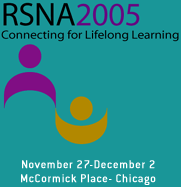
Abstract Archives of the RSNA, 2005
SSQ01-09
Computerized Classification of CAD-detected Visible, Non-actionable Lesions in Previously Overlooked Breast Cancers
Scientific Papers
Presented on December 1, 2005
Presented as part of SSQ01: Breast (Computer-assisted Detection)
Richard Lederman MD, Abstract Co-Author: Nothing to Disclose
Shalom S. Buchbinder MD, Presenter: Nothing to Disclose
Scott Ira Fields MD, Abstract Co-Author: Nothing to Disclose
Fani Sperber MD, Abstract Co-Author: Nothing to Disclose
Philippe Bamberger PhD, Abstract Co-Author: Nothing to Disclose
Isaac Leichter PhD, Abstract Co-Author: Nothing to Disclose
To assess the performance of a computer aided classification (CAC) scheme on previously overlooked cancers that were CAD-detected but considered non-actionable in a retrospective blinded study.
366 cases with prior mammograms that were originally interpreted as normal or benign, 9-24 months prior to the mammogram that led to cancer diagnosis were obtained from three institutions. In 253 cases the lesions were considered visible to some extent on the prior mammogram by two non-blinded (designated) radiologists who independently compared the current and prior mammograms. Three independent blinded (panel) radiologists analyzed these prior cases retrospectively, and marked any suspicious finding. These 253 prior mammograms were processed by the detection tier of a CAD device in order to detect suspicious findings. In 136 cases the suspicious lesions were CAD-detected. Of these, 53 lesions were non-actionable since either none or only one of the 3 blinded radiologists marked the suspicious lesion. These lesions were analyzed by the classification tier (CAC) of the CAD device in order to assess their level of suspicion.
87% (47 of 53) of the previously overlooked cancers that were CAD-detected but considered non-actionable, were correctly classified by the advanced computerized classification scheme. In these 47 cases, the analysis of the detected lesion by the classification tier yielded a high level of suspicion. In 4 cases it yielded a low level of suspicion and in 2 cases an intermediate level of suspicion was obtained. Thirty three of the 53 lesions were masses, and 28 of them were correctly classified by the classification tier. Fourteen of the 15 clusters, and all 5 masses which contained calcifications were correctly classified.
While it is generally accepted, that not all prompts from a CAD device with detection capabilities only, would influence the radiologist who prospectively interprets the mammogram, this study shows that the use of a two-tiered system with classification capabilities could influence radiologists differently, when a high level of suspicion for the detected lesion is obtained.
R.L.,S.S.B.,S.I.F.,F.S.: I am a consultant of the sponsor of the abstractP.B.,I.L.: I am a worker of the sponsor of the abstract
Lederman, R,
Buchbinder, S,
Fields, S,
Sperber, F,
Bamberger, P,
Leichter, I,
Computerized Classification of CAD-detected Visible, Non-actionable Lesions in Previously Overlooked Breast Cancers. Radiological Society of North America 2005 Scientific Assembly and Annual Meeting, November 27 - December 2, 2005 ,Chicago IL.
http://archive.rsna.org/2005/4410626.html

